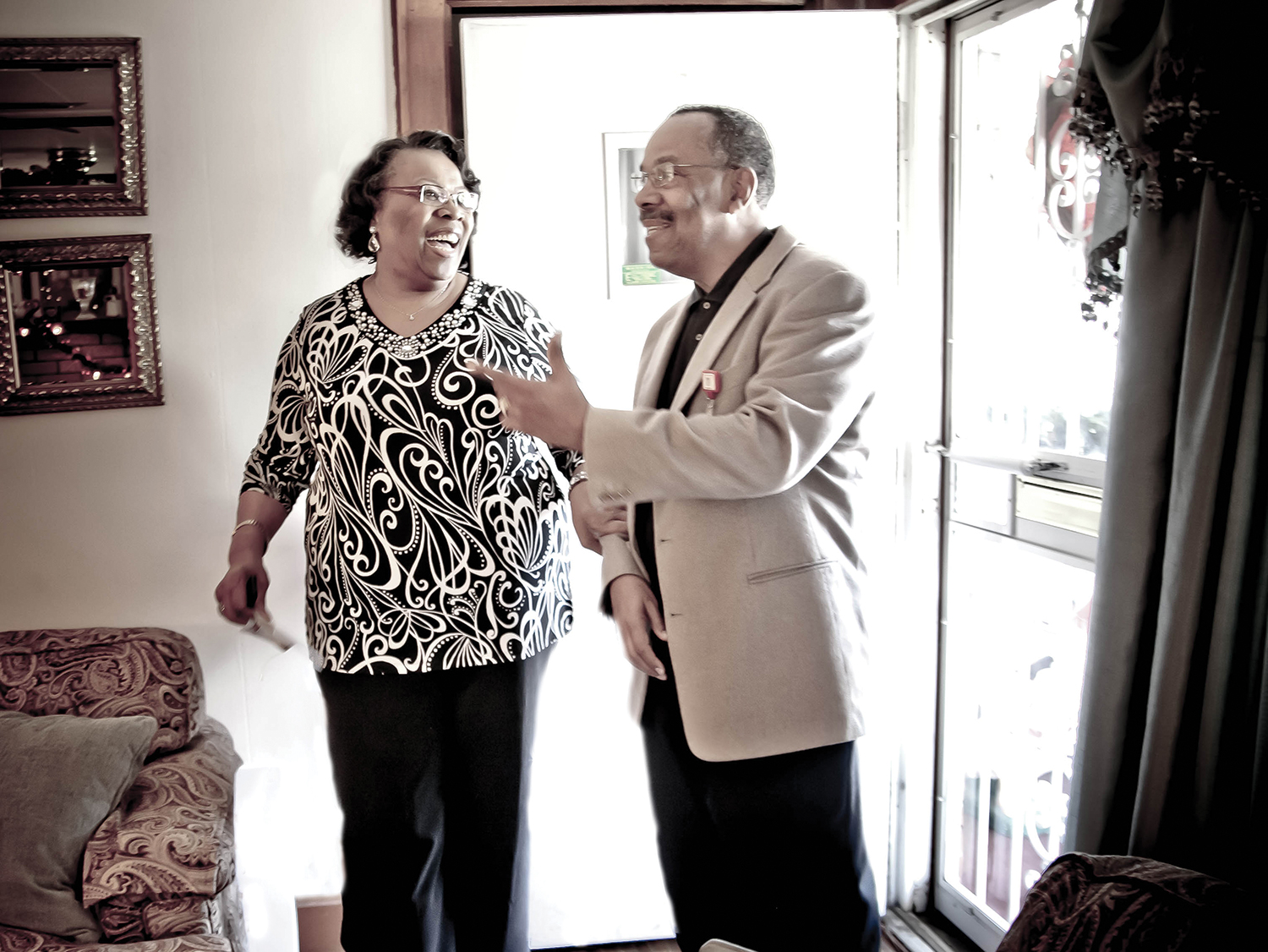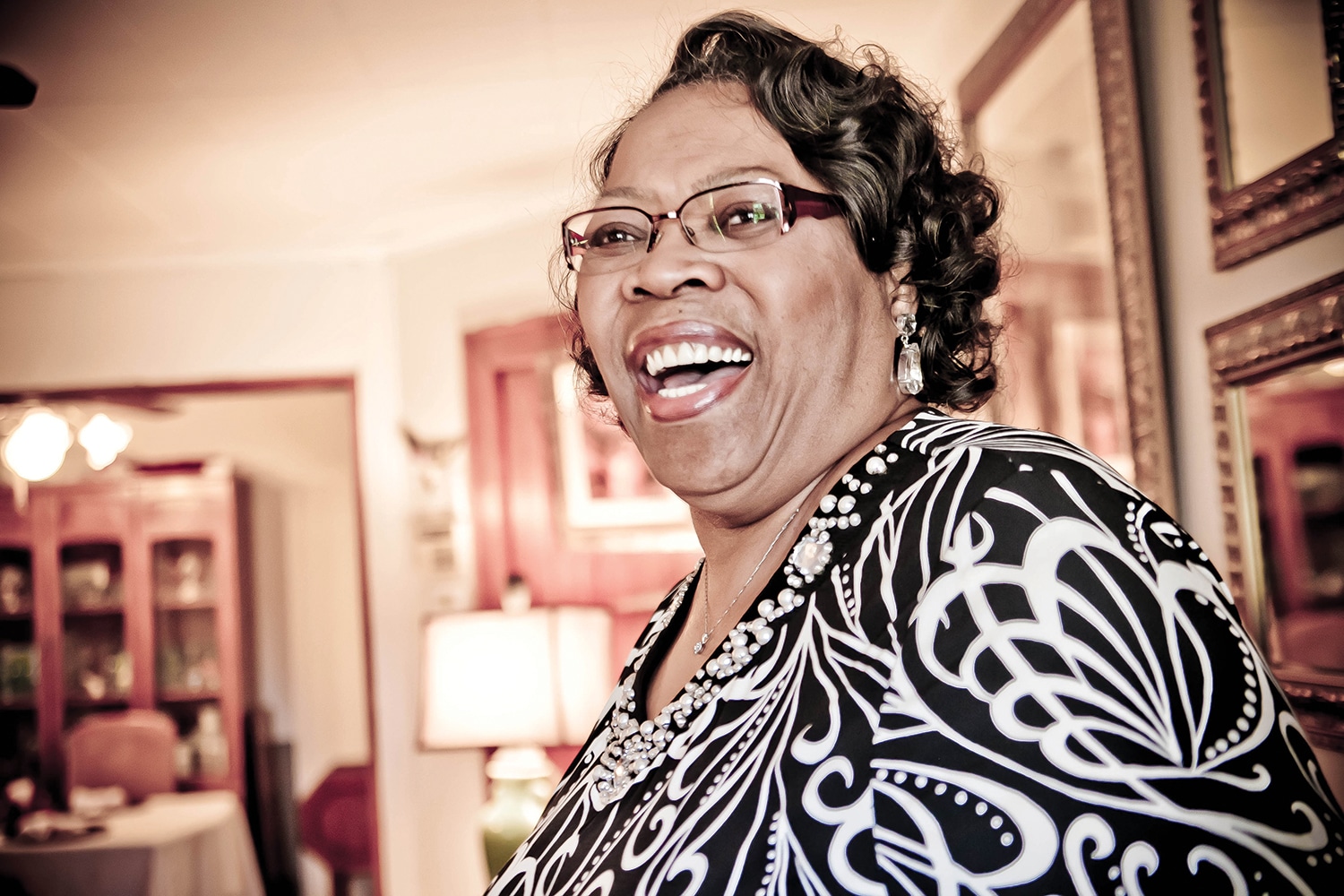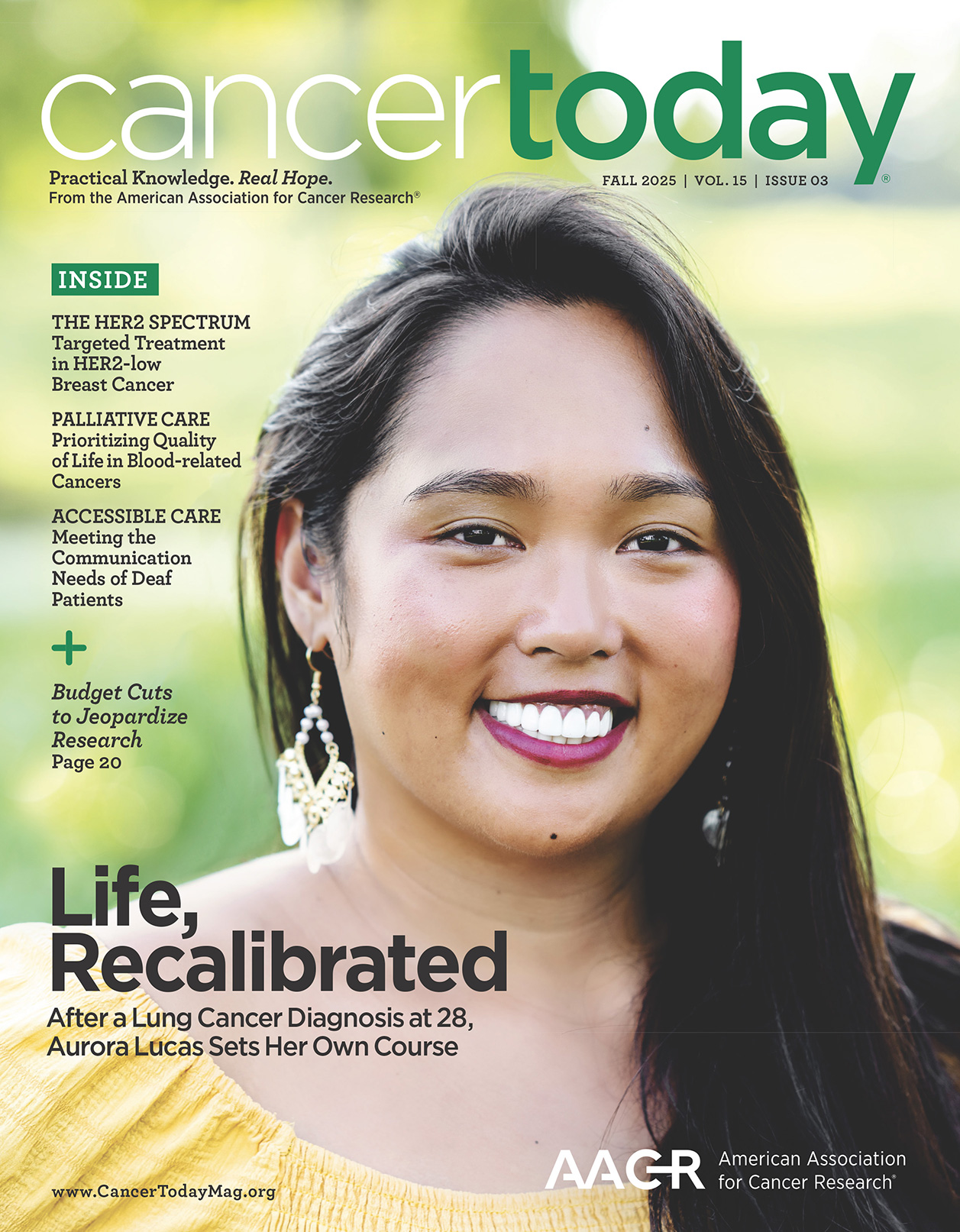IN 2009, Phyllis L. Fouse, a retired teacher’s aide who had just been diagnosed with leukemia, was praying hard for strength before meeting with her oncologist about her blood work.
“And the spirit of God spoke to me and said, ‘You can make this journey as long as you know I’m on your side.’ ” she recounts. “And I said, ‘A journey?’ ” The 72-year-old, who is quick to laugh, cracks up as she shares the memory.
“I knew that it wasn’t going to be overnight—OK?”
Fouse was right: The treatment path for this mother of four from Columbus, Ohio, wouldn’t be short or easy. Her regimen, part of a clinical trial, involved the chemotherapy drug Fludara (fludarabine) and the drug Rituxan (rituximab). At one point, she developed sepsis—a severe bacterial infection—and required intravenous antibiotics. She completed only four of seven prescribed rounds of treatment for her stage IV chronic lymphocytic leukemia (CLL) before signs of toxicity, including worrisome liver-function results, caused her treatment to be cut short.
But Fouse experienced “a wonderful response” to even this abbreviated version of the clinical trial regimen, according to William J. Hicks, her oncologist and a professor at Wexner Medical Center at the Ohio State University in Columbus. By late 2010, Fouse was declared in clinical remission, after bone marrow and other tests found no signs of leukemia.
The prognosis for Fouse, who is black, is encouraging so far. What’s discouraging is that other black patients don’t share her outcome often enough, according to national data. Part of the problem, says Hicks, is that not all patients are provided the best medical options, including information about clinical trials, and walked through the complexities of each option. A series of recent studies adds to the growing evidence that stubborn survival differences between black patients and white patients stem from more than differences in biology or delays in diagnosis: For reasons that doctors and researchers are still trying to unravel, treatment patterns among the two racial groups don’t match up.

Leukemia survivor Phyllis L. Fouse has built a warm and confident relationship with her oncologist, William J. Hicks. Fouse’s prognosis is encouraging so far, says Hicks, but too few other black patients are provided the best medical options and guidance. Photo by Doug Sanford
Survival and Treatment Differences
The survival gaps among cancer patients of different races can be stark and sometimes substantial, according to an article published in the Journal of the American College of Surgeons in 2010, which reviewed National Cancer Institute survival data, along with research that examined treatment differences between blacks and whites. For 10 common cancers, the five-year survival rates were higher for whites than for black patients, according to the analysis of data spanning 1995 to 2003.
Notably, the biggest racial survival gaps tended to be associated with cancers for which standard treatments most improve patients’ prognoses—suggesting that better care might have made a difference. For uterine, breast and colorectal cancers, the five-year survival rates of white patients exceeded those of black patients by wide margins: by about 25 percentage points for uterine cancer, 13 percentage points for breast cancer and 10 percentage points for colorectal cancer. In comparison, the survival differences were much narrower, 3 percentage points or less, for lung, liver and pancreatic cancers—diseases for which standard treatments have a smaller impact on survival.
Some cancers can be more aggressive in blacks, says Arden M. Morris, a colorectal cancer surgeon at the University of Michigan Medical School in Ann Arbor, who led the study. “That partially accounts for the survival disparities,” she says. “But [it] certainly does not account for the majority of the survival disparity between blacks and whites.” Based on their analyses, she and her colleagues believe that larger influences may include the fact that black patients are less likely to receive surgery or chemotherapy, and they are more likely to be treated at lower-quality hospitals.
Several other recent studies, which focused on specific cancers, have struck a recurring theme: Black patients are less likely than whites to receive recommended treatment.
Lung cancer: One analysis, which looked at the surgical rate in early stage non—small cell lung cancer, found that 66 percent of white patients underwent surgery compared with just 55 percent of black patients. Moreover, black patients with two or more significant medical conditions, such as congestive heart failure, were highly unlikely to be rolled into the operating room—just 13 percent had surgery compared with 39 percent of white patients in similar health, according to the 2010 Journal of the American Medical Association (JAMA) study, involving 386 patients.
Breast cancer: Older white patients are more likely to receive radiation, the standard treatment, following breast-conserving surgery for invasive breast cancer, according to a study published in 2010 in the journal Cancer. The results, based on an analysis of Medicare data from 2003, found that 74 percent of white patients age 65 or older underwent radiation compared with 65 percent of black women of the same age.
Colorectal cancer: Not only are white individuals more likely to survive longer after a colorectal cancer diagnosis, regardless of their tumor’s stage at diagnosis, but that survival gap has widened over time, according to a 2010 American Journal of Public Health (AJPH) analysis of survival rates from 1960 to 2005. In the 1970s, a 60-year-old white man with localized colorectal cancer would have lived only a year more, on average, than his black counterpart. By the early 2000s, that survival gap had stretched to 2.7 years.
Given that screening and treatment for colorectal cancer have improved, more so than for many other cancers, it’s important to understand why those advances have been slow to reach black patients, says Samir Soneji, a statistical demographer based at the Dartmouth Institute for Health Policy and Clinical Practice in Lebanon, N.H., who led the AJPH study. “The same things that have happened and may happen with disparities in colorectal cancers are going to happen with other cancers,” he adds, “when we start getting more effective screening.”
Closing the Gap
Samuel Cykert, who led the JAMA lung cancer study, chose to investigate which patients underwent surgery for early stage tumors because the medical benefit, he says, is clear-cut. “If you don’t have surgery, the odds are that you are going to die sooner,” he says. Interestingly, black patients who said they had a regular primary care physician were more likely to go under the knife. Perhaps, he speculates, that’s because the family physician might intervene if the patient vacillates.
Cykert’s data are just one potential example of the benefits of having a strong connection with your doctor. Yet, developing such a bond may be harder for black patients, who more often sit across a desk from a doctor of a different racial background. Nationally, nearly 13 percent of Americans are black, according to 2010 census data, but among physicians, fewer than 5 percent identify themselves as black, according to the most recent American Medical Association survey data.
Cykert, a physician and professor at the University of North Carolina School of Medicine in Chapel Hill, recommends that physicians be honest with themselves about their own perceptions, whether they are related to race or income or educational status. “As we teach medical students and young physicians,” says Cykert, “we have to almost teach a paranoia that you have to think, ‘Are the decisions I’m making the same no matter where someone comes from?’ ”
Hicks is on the same page. “We need to make sure that all [doctors] understand that we all have subtle biases that we may not even be aware of or willing to acknowledge,” he says. “We need to do whatever we can to put ourselves in the life or the lifestyle of this other individual.”
Black patients may be wary of doctors, and in particular of clinical trials, says Hicks. It’s an understandable outgrowth of a racial history that’s marked by the decades-long Tuskegee experiments, in which physicians studied but failed to treat black men with progressing syphilis, among other instances of doctors abusing patient trust, he says. “When someone comes in and talks about research,” he explains, “immediately they say, ‘Oh, this is a guinea pig situation.’ “ To help counteract that unease, Hicks discusses clinical research, including its layers of patient protection, in forums at African-American churches and social organizations.
But what can the patient do? All cancer patients should push for the best care, Cykert says. “But because of the historic disparities suffered by African-Americans, the need to advocate for oneself, to advocate for your care, to err on the side of wanting care is even greater,” he says.
If a physician advises against surgery, or describes you as a borderline candidate for surgery, Cykert suggests that you probe further. “The follow-up question should be, ‘How can I get to be a better surgical candidate? What can I do differently?’ ” The doctor might be making assumptions—for instance, that there’s a lack of sufficient family support or transportation options for an aggressive treatment regimen—that the black patient could address.
How patients present themselves also can change the physician dynamic, says Ebony Steele, the black co-host of the Rickey Smiley Morning Show. The 39-year-old, diagnosed with stage I breast cancer in 2007, serves as an ambassador for Circle of Promise, an African-American outreach initiative that’s part of Susan G. Komen for the Cure.
Steele, who currently has no signs of cancer, credits her mother for giving her faith and her father for convincing her to get a second opinion. Her sister accompanied her to doctor’s appointments—a notebook filled with questions in hand.
“If you go in there with your game face on, and you’ve done your research and you ask your questions and you are probing, then that makes a difference,” Steele says.
Other Influences
In some important ways, medical care should not be colorblind, Hicks notes. Racial differences in survival may conceal molecular clues to cancer. As researchers link genetic mutations to the effectiveness of some cancer medications, it’s important for researchers to identify mutation patterns that occur more commonly along racial lines, he says. For example, a recent study has identified a lower prevalence of mutations in a gene called KRAS in lung cancer cells from black patients than in lung cancer cells from whites—information that may help explain some survival differences among patients of different races.
And black patients may more frequently than white patients face real-life socioeconomic constraints—among them insurance coverage, family dynamics, the availability of nearby high-quality hospitals—that can alter a patient’s treatment course, says Benjamin Smith, a radiation oncologist at M. D. Anderson Cancer Center in Houston. “I think race is a marker for a higher chance of less social support or fewer financial resources that place patients at risk for falling through the cracks,” he explains.
Morris, for instance, conducted focus groups with black patients and white patients in the Detroit area who had undergone colorectal surgery but were struggling to complete additional cancer treatment. Poor patients in general—many of whom were black—thought treatment cut into time with their families and had a “hard time taking off from work to go in for chemotherapy,” she says. Morris recently received a grant to study whether anecdotal feedback from the focus groups holds up across larger populations.
Meanwhile, as researchers work to dig out the root causes of racial treatment differences, they frequently turn up new questions. In the 2010 study of radiation treatment for invasive breast cancer published in Cancer, M. D. Anderson physicians discovered that treatment differences between blacks and whites varied along regional lines, for reasons that remain unclear.
For instance, in the Midwest, radiation treatment rates exceeded 70 percent and were roughly similar among both blacks and whites. In other areas, such as the Pacific West region (Alaska, California, Hawaii, Oregon and Washington), researchers found a wide gap: Only 54 percent of black patients received radiation compared with 72 percent of whites. “I think what that suggests is there are undercurrents of differences in treatment across the United States,” says radiation oncologist Grace Li Smith, who led the study.
A Good Bond
As for Fouse, she and Hicks first developed a rapport a decade ago, when Fouse was referred to him after a chiropractor’s X-ray indicated that she might have lymphoma. (She didn’t.) When Fouse’s blood work revealed leukemia in 2009, Hicks says, he and his staff invested a lot of time to make sure that she understood the clinical trial treatment option and its risks, and that she wasn’t placing too much faith in him or in a higher power.
From Fouse’s perspective, what solidified her trust in Hicks as she began her drug regimen was not his skin color—Hicks is black—but her confidence that he has her best interests at heart. “I trust his knowledge,” she says. “And I trust him as a person.”
“Color really doesn’t matter to me—just treat me good,” says Fouse, who counts each day as a blessing. Her throaty laugh wells up again. “I don’t have time for no color barrier.”
Cancer Today magazine is free to cancer patients, survivors and caregivers who live in the U.S. Subscribe here to receive four issues per year.





